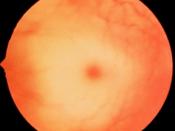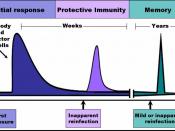March 9, 2003
Genetics and Universe Within
The immune system is greatly affected by genetics and hereditary traits. The immune system is the body's defense against pathogens, such as bacteria and viruses. The immune system is a two-part defense mechanism, with specific and non - specific defenses. Non specific defenses are defenses that function against all forms of invaders. Our skin, phagocytes and macrophages, as well as white blood cells, are all non - specific defenses. They work against all forms of invaders, not just a certain invader. Specific defenses only work against one certain type of invader, like a single strain of bacteria or virus. Specific defenses include T cells, B cells, and the antibodies they manufacture. Genetics and hereditary traits, as well as the surrounding environment influence both of these types of defenses.
Non specific defenses are our body's first line of defense. The first of these defenses we'll examine are our skin, sweat, and mucous membranes.
These defenses are generally identical from person to person, and usually are not influenced by genetics as much as the surrounding environment. For example, the skin forms calluses to prevent breaking, which prevents invaders from entering the body and doing damage. Calluses aren't formed by genes, but by environmental stress. The same is true for sweat and mucous membranes, which only react to environmental stimuli. The other non -specific defenses phagocytes and macrophages, are identical through all members of the human race, and are not dependent on individual genetics at all.
The specific defenses of the body are more complex and designed to protect us from our most serious invaders, like smallpox and polio. Specific defenses of the body function by an extremely well coordinated system of identification and eradication. First, a macrophage destroys an invader cell, and displays the antigens...


